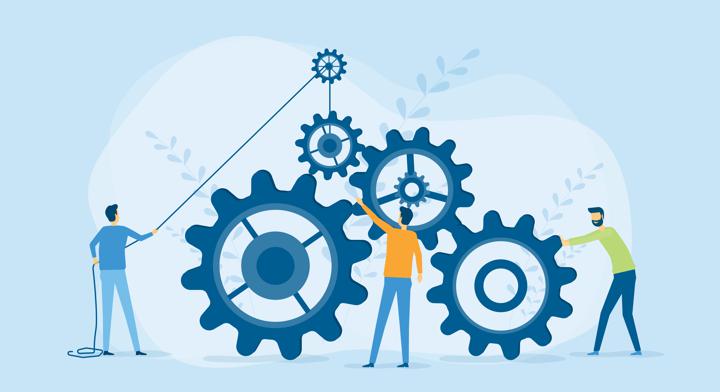
We are witnessing a new way of productivity driven by data analytics, as organizations across sectors are enhancing their ability to collect, store, analyze and present data. Data analytics has the potential to transform processes and performance, delivering substantial efficiency increases.
In order to tap into these benefits, businesses need to put the right data analytics systems and tools in place. While this does require an investment, it should not be a barrier to adoption; there are analytics tools of all kinds, including a number of open-source ones, and cloud-based systems can keep data storage costs under control. Ultimately, the benefits of increased efficiency will amply justify the investment.
Let’s start by looking at the various aspects of data analytics that need to be considered in order to implement efficiency improvement programs.
Sources of data

Analytics can use data that is available or you may find that your efficiency improvement initiative requires you to collect new and relevant data. Planning how to collect and organize data is an important part of your solution. For example, let’s consider rolling out new features in your product. In order to understand how users are responding to the new features, it’s important to set up A/B testing and collect data about how users have interacted with the product. You may not have used such automatic data gathering techniques in the past, or you may need to incorporate them at this stage in order to ensure that you have relevant data for analysis going forward.
It may not always be necessary to collect new data, as plenty of data may be available within the organization. So you need to review available data and evaluate its relevance to your analysis. Large volumes of data are not always the best for analytics; it is more important to have data that is relevant to the specific objectives of the exercise and of a quality that will ensure that the results are meaningful.
Real-time insights
Data that is available after events have transpired loses some degree of relevance and limits the capability to make data-driven decisions. Immediacy, on the other hand, can be a game-changer in many business situations. For example, a contact center can immediately improve customer service by identifying trends in queries, causes for dissonance, reasons for delayed responses, frequently asked questions and training needs of contact agents. If real-time reporting is provided then contact agents can better understand users while interacting with them and become more efficient. They can be better prepared with responses, reduce the duration of calls and improve the user experience.
Let’s look at one more example of the power of real-time reporting: the need to manage security at multiple properties such as factories, offices, and warehouses belonging to the company. Security cameras deployed at multiple locations gather footage. In case of any security breach or potential incident, real-time analysis is essential in order to take immediate action and prevent loss or damage. So the system must have the ability to analyze the video footage in real-time and flag any possible areas of concern; post facto analysis will not have the same value at all.
Historical data
While real-time reporting enables speedy action, often while the event is occurring, historical data has its own importance. If we look at the contact center example once again, historical data can help train contact agents based on how callers have behaved in the past. You can build predictive models to prepare for how they are likely to behave in the future. Historical data can help you to prepare for peak times with more staff and become lean during less busy times. Historical data can also help to know which products should be recommended to which kinds of customers, so as to increase the chances of conversions and grow sales.
A data-driven culture

While it is essential for senior leadership to see the value of data analytics and stress its adoption throughout the organization, in reality, the effective use of data cannot be the responsibility of a small handful of people. The true benefits of data analytics accrue only when the organization culture at all levels is geared to leverage data and willing to make process changes to enhance efficiency, and decisions are based on data and not hunches.
Further, once a decision has been made, analytics can still be used to track its effectiveness, learn from failures and make better choices in the future.
As an example, consider a business that uses algorithms to decide whether to display or pause online advertising based on the availability of customer service representatives to handle responses to the ads. Such an approach becomes possible when various people and teams work in a coordinated manner to make the best use of data analytics. Such a system enhances the efficiency of the customer service representatives, as well as the ROI from the digital advertising campaigns.
In some companies, data scientists form a data analytics department, while in others they are deeply embedded in cross-functional teams. Many people now believe that data analytics experts should be at the core of business decision making and not viewed as a support function.
Let’s now turn our attention to some of the benefits that can be expected from the right data analytics approach.
Data analytics for enhanced team performance and productivity increase

With data analytics, an organization can achieve continual performance improvement, as teams and leaders get an improved understanding of processes and results. Areas of improvement can be identified and factors that are negatively impacting productivity can be resolved.
Data tools enable us to combine data about people and teams across departments, locations and functions. Analysis can be done organization-wide or based on any other categorization. This helps to understand the patterns and trends of various people-related parameters, such as employee satisfaction, attrition, performance ratings, salaries, etc.
Profitability improvement through data analytics
The effective use of data analytics has been proven to lead to increased revenue and profitability in many different organizations. Companies that invest in the quality and accessibility of data reap financial gain from revenue growth.
Business processes can be effectively analyzed when data is available. When a problem or area for improvement is identified, analytics helps to diagnose issues, understand possible causes, predict whether this problem may recur, and recommend the best course of action. This approach can be used for the improvement of any business process throughout the organization.
Data analytics enables decision-makers and stakeholders to understand expenses versus budgets, sales versus targets, the status of planned initiatives, and to view data by region, or product, or department. Decisions are now taken with a sound understanding of financial positions and implications.
Data analytics for better sales forecasting

The ability to forecast sales accurately is extremely valuable for many reasons. Sales managers can monitor whether the team is on track to achieve targets, and departments responsible for fulfilling orders, such as production and logistics, can get prepared based on the expected closures. In most B2B sales teams a CRM application is used to capture many different data points about sales operations. Data analytics can forecast the expected success rate based on these data points.
Forecasting is even more critical in B2C businesses, such as retail or e-commerce. Effective forecasting helps to plan stocking, distribution, manufacture and supply chain so as to meet demand, prevent pile-up of unsold stocks or stock out situations. This has a huge impact on customer satisfaction, brand perception, revenues, as well as costs. Data analytics for forecasting sales accurately has a huge impact on the efficiency of the organization.
Data analytics for resource optimization
Data analytics provides extremely powerful and effective ways to ensure that resources are utilized in the most efficient and optimized manner. Whether it’s real estate resources, production machinery or cloud storage, analytics can continuously monitor utilization, costs, forecast future requirements and provision resources optimally. Analytics can also help managers to understand power consumption, heating, and water usage, and take steps to ensure that they are used optimally.
The analysis of past trends and forecasts of future requirements can help make suitable provisions of resources without excess capacity creation and wastage.
In order to gain these efficiency increases through the use of data analytics in business, a clear set of objectives and the right combination of people, processes, and technologies must be brought together effectively.
